Rear light Lancia Musa 2010 Owner handbook (in English)
[x] Cancel search | Manufacturer: LANCIA, Model Year: 2010, Model line: Musa, Model: Lancia Musa 2010Pages: 218, PDF Size: 3.71 MB
Page 82 of 218
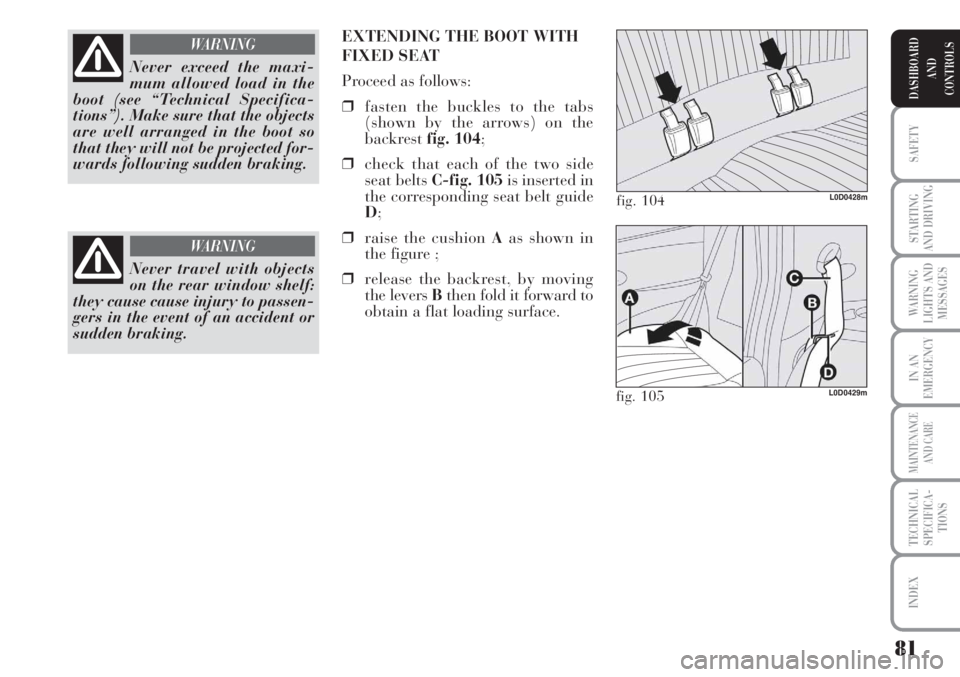
81
SAFETY
STARTING
AND DRIVING
WARNING
LIGHTS AND
MESSAGES
IN AN
EMERGENCY
MAINTENANCE
AND CARE
TECHNICAL
SPECIFICA-
TIONS
INDEX
DASHBOARD
AND
CONTROLS
Never exceed the maxi-
mum allowed load in the
boot (see “Technical Specifica-
tions”). Make sure that the objects
are well arranged in the boot so
that they will not be projected for-
wards following sudden braking.
WARNING
Never travel with objects
on the rear window shelf:
they cause cause injury to passen-
gers in the event of an accident or
sudden braking.
WARNING
EXTENDING THE BOOT WITH
FIXED SEAT
Proceed as follows:
❒fasten the buckles to the tabs
(shown by the arrows) on the
backrestfig. 104;
❒check that each of the two side
seat belts C-fig. 105is inserted in
the corresponding seat belt guide
D;
❒raise the cushion Aas shown in
the figure ;
❒release the backrest, by moving
the levers Bthen fold it forward to
obtain a flat loading surface.
fig. 104L0D0428m
fig. 105L0D0429m
Page 86 of 218

85
SAFETY
STARTING
AND DRIVING
WARNING
LIGHTS AND
MESSAGES
IN AN
EMERGENCY
MAINTENANCE
AND CARE
TECHNICAL
SPECIFICA-
TIONS
INDEX
DASHBOARD
AND
CONTROLS
ABS SYSTEM
The car is fitted with an ABS braking
system, which prevents the wheels
from locking when braking, makes
the most of road grip and gives the
best control when emergency braking
under difficulty road conditions.
System is completed by EBD (Elec-
tronic Braking force Distribution),
which distributes the braking action
between front and rear wheels.
IMPORTANT The braking system
needs to settle for approximately 500
km: during this time, avoid sudden,
repeated and prolonged braking.SYSTEM INTERVENTION
Intervention of the ABS is detected by
a slight pulsing of the brake pedal ac-
companied by noise: such an event in-
dicates that you need to adjust your
speed to the type of road on which
you are travelling.
MECHANICAL BRAKE ASSIST
(emergency braking assistance)
(for versions/markets, where
provided)
This system (which cannot be deacti-
vated) recognises emergency braking
conditions according to the speed of
operation of the brake pedal and pro-
vides an additional hydraulic braking
pressure to support that provided by
the driver. This allows faster and
more powerful operation of the
braking system.
IMPORTANT When the Mechanical
Brake Assist is activated noises can be
heard from the system. This is nor-
mal. Anyway, while braking keep the
brake pedal depressed.
When the ABS intervenes
it means that you are ap-
proaching the grip limit between
tyres and road: slow down to ex-
ploit all the available grip.
WARNING
The ABS exploits the tyre-
road grip at the best, but it
cannot improve it; you should
therefore take every care when dri-
ving on slippery surfaces without
taking unnecessary risks.
WARNING
FAILURE INDICATIONS
ABS failure
ABS failure is indicated by the turn-
ing on of warning light >on the in-
strument panel together with the ded-
icated message on the multifunctional
display (for versions/markets, where
provided), (see section “Warning
lights and messages”).
In the case, the braking system will
work as normal without the extra po-
tentials offered by the ABS system.
Drive carefully to the nearest Lancia
Dealership to have the system
checked.
EBD failure
ABS failure is indicated by the
turning on warning lights >andx
on the instrument panel together with
a message on the multifunctional
display (for versions/markets, where
provided), (see section “Warning
lights and messages”).
Page 87 of 218
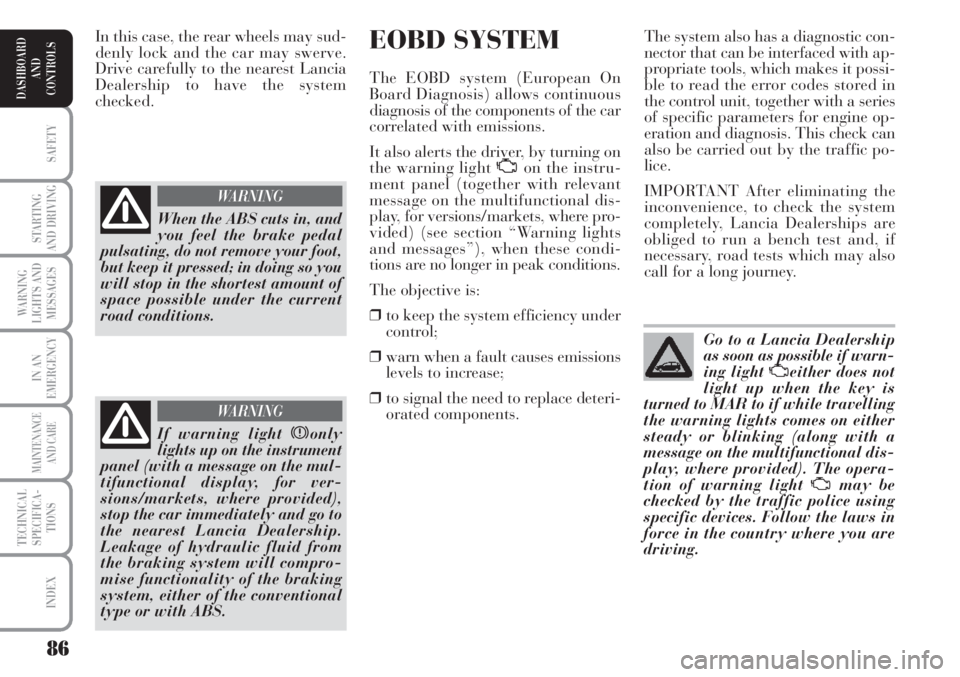
86
SAFETY
STARTING
AND DRIVING
WARNING
LIGHTS AND
MESSAGES
IN AN
EMERGENCY
MAINTENANCE
AND CARE
TECHNICAL
SPECIFICA-
TIONS
INDEX
DASHBOARD
AND
CONTROLS
EOBD SYSTEM
The EOBD system (European On
Board Diagnosis) allows continuous
diagnosis of the components of the car
correlated with emissions.
It also alerts the driver, by turning on
the warning light
Uon the instru-
ment panel (together with relevant
message on the multifunctional dis-
play, for versions/markets, where pro-
vided) (see section “Warning lights
and messages”), when these condi-
tions are no longer in peak conditions.
The objective is:
❒to keep the system efficiency under
control;
❒warn when a fault causes emissions
levels to increase;
❒to signal the need to replace deteri-
orated components. In this case, the rear wheels may sud-
denly lock and the car may swerve.
Drive carefully to the nearest Lancia
Dealership to have the system
checked.The system also has a diagnostic con-
nector that can be interfaced with ap-
propriate tools, which makes it possi-
ble to read the error codes stored in
the control unit, together with a series
of specific parameters for engine op-
eration and diagnosis. This check can
also be carried out by the traffic po-
lice.
IMPORTANT After eliminating the
inconvenience, to check the system
completely, Lancia Dealerships are
obliged to run a bench test and, if
necessary, road tests which may also
call for a long journey.
When the ABS cuts in, and
you feel the brake pedal
pulsating, do not remove your foot,
but keep it pressed; in doing so you
will stop in the shortest amount of
space possible under the current
road conditions.
WARNING
If warning light xonly
lights up on the instrument
panel (with a message on the mul-
tifunctional display, for ver-
sions/markets, where provided),
stop the car immediately and go to
the nearest Lancia Dealership.
Leakage of hydraulic fluid from
the braking system will compro-
mise functionality of the braking
system, either of the conventional
type or with ABS.
WARNING
Go to a Lancia Dealership
as soon as possible if warn-
ing light Ueither does not
light up when the key is
turned to MAR to if while travelling
the warning lights comes on either
steady or blinking (along with a
message on the multifunctional dis-
play, where provided). The opera-
tion of warning light Umay be
checked by the traffic police using
specific devices. Follow the laws in
force in the country where you are
driving.
Page 88 of 218

87
SAFETY
STARTING
AND DRIVING
WARNING
LIGHTS AND
MESSAGES
IN AN
EMERGENCY
MAINTENANCE
AND CARE
TECHNICAL
SPECIFICA-
TIONS
INDEX
DASHBOARD
AND
CONTROLS
Sound system installation
The sound system must be installed
in the space occupied by the central
oddment compartment where the
wiring leads. To extract the compart-
ment, press in the points shown at the
retainer systems.
SOUND SYSTEM
(for versions/markets, where provided)
Refer to the supplement to this
Owner’s Handbook for operating the
sound system with CD or with CD
MP3.
SOUND SYSTEM SETUP
(for versions/markets, where provided)
The system consists of:
❒sound system power wires
❒front and rear speaker power wires
❒aerial power wire
❒2 tweeters on front pillars (30W
max power each);
❒2 mid-woofers on front doors (165
mm diameter, 30W max power
each);
❒2 full-range speaker on front doors
(165 mm diameter, 30W max
power each).
fig. 113L0D0120m
It is advisable to have the
sound system and interfer-
ence filter installed by a
Lancia Dealership.
GSI SYSTEM
(for versions with
mechanical
gearbox only)
(for versions/markets, where provided)
The gear shift indication makes it
possible, on cars with a manual gear-
box, to suggest the driver should
change gear (higher gear: shift up, see
Fig. aor lower gear: shift down, see
Fig. b), through a dedicated indica-
tion in the control panel. This sug-
gestion to change gear is designed to
improve consumption and ensure the
best driving style.
NOTE: the indication in the instru-
ment panel remains on until the dri-
ver makes a gear change or until the
driving conditions return to a situa-
tion where a gear change is not re-
quired to improve consumption.
fig. a fig. b
Page 91 of 218
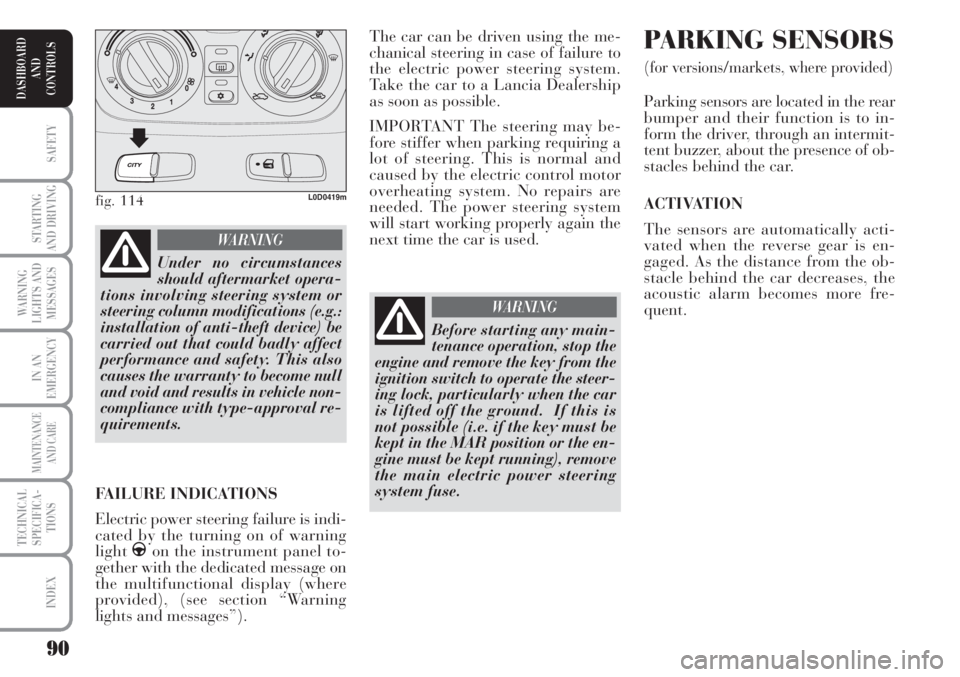
90
SAFETY
STARTING
AND DRIVING
WARNING
LIGHTS AND
MESSAGES
IN AN
EMERGENCY
MAINTENANCE
AND CARE
TECHNICAL
SPECIFICA-
TIONS
INDEX
DASHBOARD
AND
CONTROLS
The car can be driven using the me-
chanical steering in case of failure to
the electric power steering system.
Take the car to a Lancia Dealership
as soon as possible.
IMPORTANT The steering may be-
fore stiffer when parking requiring a
lot of steering. This is normal and
caused by the electric control motor
overheating system. No repairs are
needed. The power steering system
will start working properly again the
next time the car is used. PARKING SENSORS
(for versions/markets, where provided)
Parking sensors are located in the rear
bumper and their function is to in-
form the driver, through an intermit-
tent buzzer, about the presence of ob-
stacles behind the car.
ACTIVATION
The sensors are automatically acti-
vated when the reverse gear is en-
gaged. As the distance from the ob-
stacle behind the car decreases, the
acoustic alarm becomes more fre-
quent.
fig. 114L0D0419m
Under no circumstances
should aftermarket opera-
tions involving steering system or
steering column modifications (e.g.:
installation of anti-theft device) be
carried out that could badly affect
performance and safety. This also
causes the warranty to become null
and void and results in vehicle non-
compliance with type-approval re-
quirements.
WARNING
FAILURE INDICATIONS
Electric power steering failure is indi-
cated by the turning on of warning
light
gon the instrument panel to-
gether with the dedicated message on
the multifunctional display (where
provided), (see section “Warning
lights and messages”).
Before starting any main-
tenance operation, stop the
engine and remove the key from the
ignition switch to operate the steer-
ing lock, particularly when the car
is lifted off the ground. If this is
not possible (i.e. if the key must be
kept in the MAR position or the en-
gine must be kept running), remove
the main electric power steering
system fuse.
WARNING
Page 97 of 218

96
STARTING
AND DRIVING
WARNING
LIGHTS AND
MESSAGES
IN AN
EMERGENCY
MAINTENANCE
AND CARE
TECHNICAL
SPECIFICA-
TIONS
INDEX
DASHBOARD
AND
CONTROLS
SAFETY
SEAT BELTS
USING THE FRONT
AND SIDE REAR
SEAT BELTS
The belt should be worn keeping the
chest straight and rested against the
seat back.
To fasten the seat belts, take hold the
tongueA-fig. 1and insert it into the
buckleB, until hearing the locking
click.
On removal, if it jams, let it rewind
for a short stretch, then pull it out
again without jerking.
Press button Cto release the belt. Ac-
company the belt while it is being re-
wound to prevent twisting.
Through the reel, the belt automati-
cally adapts to the body of the pas-
senger wearing it, allowing freedom of
movement.The reel may lock when the car is
parked on a steep slope: this is per-
fectly normal. Furthermore, the reel
mechanism locks the belt if it is pulled
and in the event of sudden braking,
collisions and on high speed bends.
The rear seat is fitted with inertial
seat belts with three anchor points
and reel.Rear seat belts must be worn as
shown in diagram D-fig. 2(five seat
versions) or as shown in diagram
E-fig. 3(four seat versions).
fig. 1L0D0126m
fig. 2L0D0430m
fig. 3L0D0431m
Never press button C-fig. 1
when travelling.
WARNING
Page 101 of 218
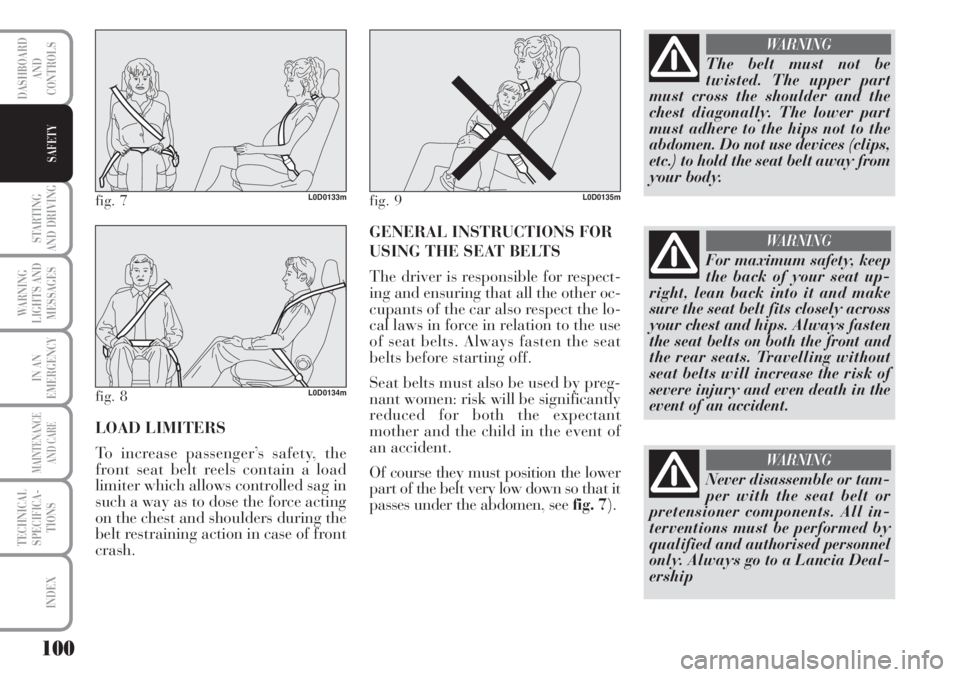
100
STARTING
AND DRIVING
WARNING
LIGHTS AND
MESSAGES
IN AN
EMERGENCY
MAINTENANCE
AND CARE
TECHNICAL
SPECIFICA-
TIONS
INDEX
DASHBOARD
AND
CONTROLS
SAFETY
LOAD LIMITERS
To increase passenger’s safety, the
front seat belt reels contain a load
limiter which allows controlled sag in
such a way as to dose the force acting
on the chest and shoulders during the
belt restraining action in case of front
crash.GENERAL INSTRUCTIONS FOR
USING THE SEAT BELTS
The driver is responsible for respect-
ing and ensuring that all the other oc-
cupants of the car also respect the lo-
cal laws in force in relation to the use
of seat belts. Always fasten the seat
belts before starting off.
Seat belts must also be used by preg-
nant women: risk will be significantly
reduced for both the expectant
mother and the child in the event of
an accident.
Of course they must position the lower
part of the belt very low down so that it
passes under the abdomen, see fig. 7).
fig. 7L0D0133m
fig. 8L0D0134m
fig. 9L0D0135m
The belt must not be
twisted. The upper part
must cross the shoulder and the
chest diagonally. The lower part
must adhere to the hips not to the
abdomen. Do not use devices (clips,
etc.) to hold the seat belt away from
your body.
WARNING
Never disassemble or tam-
per with the seat belt or
pretensioner components. All in-
terventions must be performed by
qualified and authorised personnel
only. Always go to a Lancia Deal-
ership
WARNING
For maximum safety, keep
the back of your seat up-
right, lean back into it and make
sure the seat belt fits closely across
your chest and hips. Always fasten
the seat belts on both the front and
the rear seats. Travelling without
seat belts will increase the risk of
severe injury and even death in the
event of an accident.
WARNING
Page 103 of 218
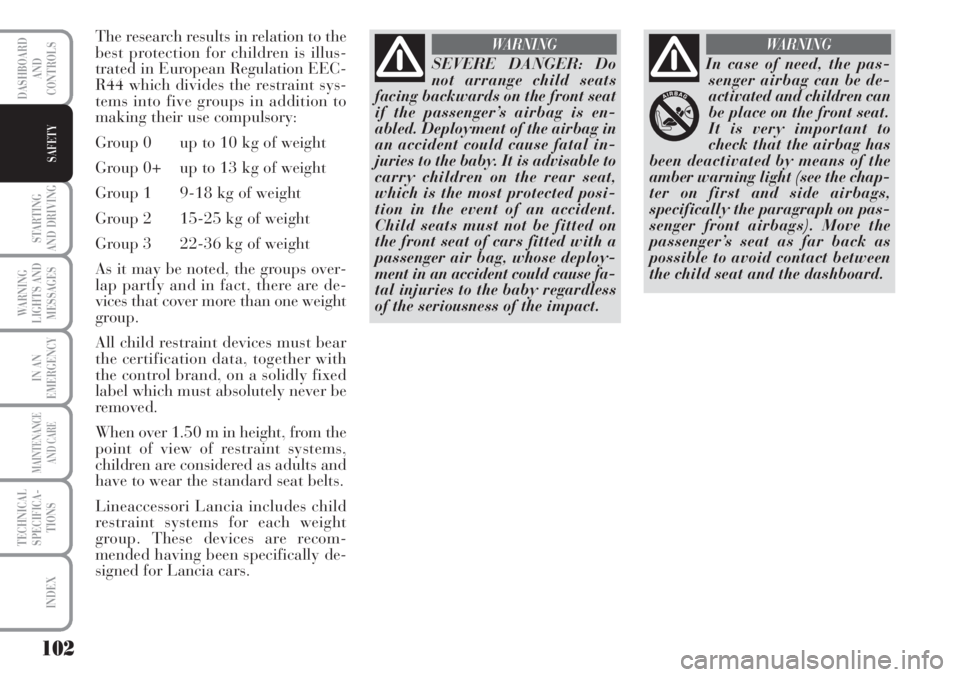
102
STARTING
AND DRIVING
WARNING
LIGHTS AND
MESSAGES
IN AN
EMERGENCY
MAINTENANCE
AND CARE
TECHNICAL
SPECIFICA-
TIONS
INDEX
DASHBOARD
AND
CONTROLS
SAFETY
The research results in relation to the
best protection for children is illus-
trated in European Regulation EEC-
R44 which divides the restraint sys-
tems into five groups in addition to
making their use compulsory:
Group 0 up to 10 kg of weight
Group 0+ up to 13 kg of weight
Group 1 9-18 kg of weight
Group 2 15-25 kg of weight
Group 3 22-36 kg of weight
As it may be noted, the groups over-
lap partly and in fact, there are de-
vices that cover more than one weight
group.
All child restraint devices must bear
the certification data, together with
the control brand, on a solidly fixed
label which must absolutely never be
removed.
When over 1.50 m in height, from the
point of view of restraint systems,
children are considered as adults and
have to wear the standard seat belts.
Lineaccessori Lancia includes child
restraint systems for each weight
group. These devices are recom-
mended having been specifically de-
signed for Lancia cars.
SEVERE DANGER: Do
not arrange child seats
facing backwards on the front seat
if the passenger’s airbag is en-
abled. Deployment of the airbag in
an accident could cause fatal in-
juries to the baby. It is advisable to
carry children on the rear seat,
which is the most protected posi-
tion in the event of an accident.
Child seats must not be fitted on
the front seat of cars fitted with a
passenger air bag, whose deploy-
ment in an accident could cause fa-
tal injuries to the baby regardless
of the seriousness of the impact.
WARNING
In case of need, the pas-
senger airbag can be de-
activated and children can
be place on the front seat.
It is very important to
check that the airbag has
been deactivated by means of the
amber warning light (see the chap-
ter on first and side airbags,
specifically the paragraph on pas-
senger front airbags). Move the
passenger’s seat as far back as
possible to avoid contact between
the child seat and the dashboard.
WARNING
Page 105 of 218

104
STARTING
AND DRIVING
WARNING
LIGHTS AND
MESSAGES
IN AN
EMERGENCY
MAINTENANCE
AND CARE
TECHNICAL
SPECIFICA-
TIONS
INDEX
DASHBOARD
AND
CONTROLS
SAFETY
fig. 13L0D0139m
GROUP 3 fig. 13
For children between 22 kg and 36
kg, there are boosters allowing the
seatbelt to fit correctly.
The figure shows proper child seat po-
sitioning on the rear seat.
Children taller than 1.50 m can wear
seat belts like adults.
The figure is indicative for
assembly purposes only.
Refer to the instructions supplied
with the child restraint.
WARNING
SUITABILITY OF PASSENGER SEATS FOR CHILD SEAT USE
The car complies with the new European Directive 2000/3/EC which governs
the arrangement possibilities for child restraints on the various seats of the car
as shown in the following table:
CAR SEAT
Group Weight group Passenger Passenger Passenger
front rear central
side
(for versions/markets,where provided)
Group 0, 0+ up to 13 kg U U *
Group 1 9 -18 kg U U *
Group 2 15 -25 kg U U *
Group 3 22 -36 kg U U *
Key:
U = suitable for child restraint systems of the “Universal” category, according
to European Standard EEC-R44 for the specified “Groups”.
* Never mount child restraint systems on the rear central seat.
Page 106 of 218
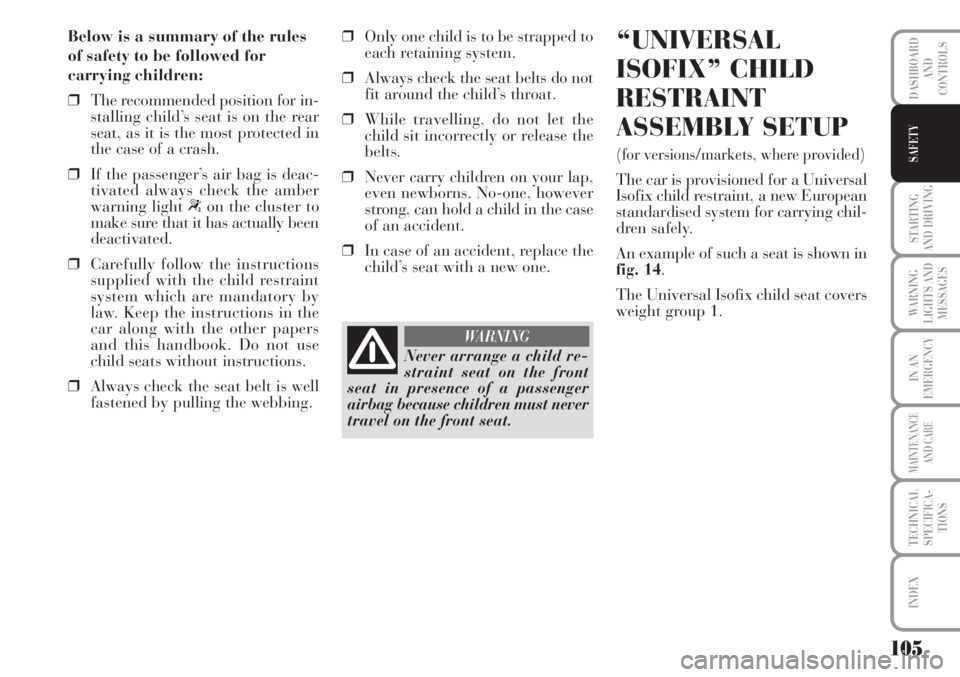
105
STARTING
AND DRIVING
WARNING
LIGHTS AND
MESSAGES
IN AN
EMERGENCY
MAINTENANCE
AND CARE
TECHNICAL
SPECIFICA-
TIONS
INDEX
DASHBOARD
AND
CONTROLS
SAFETY
Below is a summary of the rules
of safety to be followed for
carrying children:
❒The recommended position for in-
stalling child’s seat is on the rear
seat, as it is the most protected in
the case of a crash.
❒If the passenger’s air bag is deac-
tivated always check the amber
warning light “on the cluster to
make sure that it has actually been
deactivated.
❒Carefully follow the instructions
supplied with the child restraint
system which are mandatory by
law. Keep the instructions in the
car along with the other papers
and this handbook. Do not use
child seats without instructions.
❒Always check the seat belt is well
fastened by pulling the webbing.❒Only one child is to be strapped to
each retaining system.
❒Always check the seat belts do not
fit around the child’s throat.
❒While travelling, do not let the
child sit incorrectly or release the
belts.
❒Never carry children on your lap,
even newborns. No-one, however
strong, can hold a child in the case
of an accident.
❒In case of an accident, replace the
child’s seat with a new one. “UNIVERSAL
ISOFIX” CHILD
RESTRAINT
ASSEMBLY SETUP
(for versions/markets, where provided)
The car is provisioned for a Universal
Isofix child restraint, a new European
standardised system for carrying chil-
dren safely.
An example of such a seat is shown in
fig. 14.
The Universal Isofix child seat covers
weight group 1.
Never arrange a child re-
straint seat on the front
seat in presence of a passenger
airbag because children must never
travel on the front seat.
WARNING